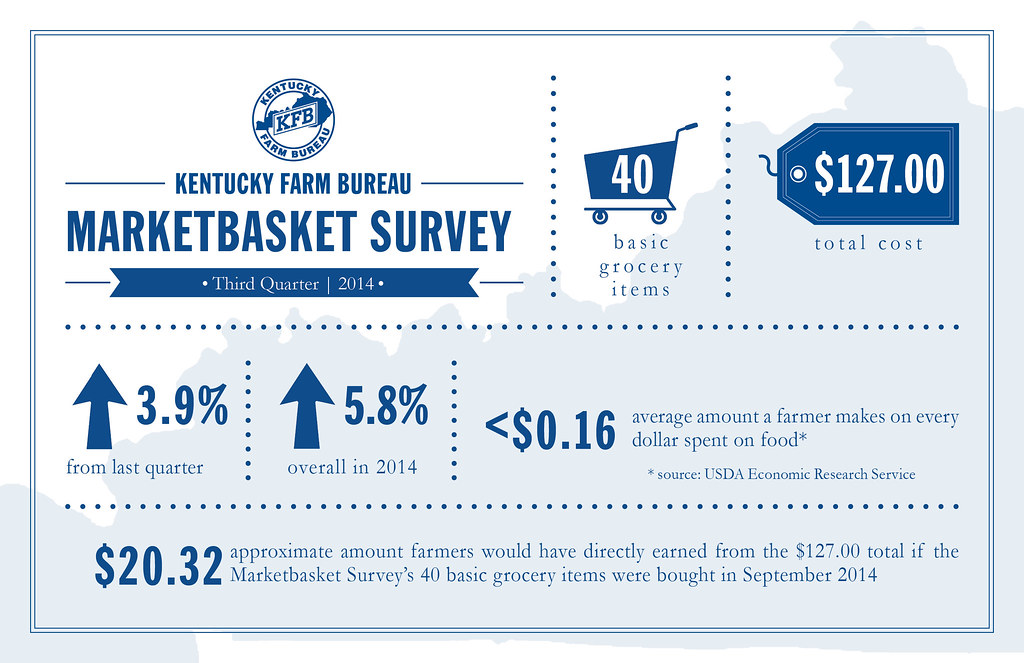Beef and pork prices push Kentucky retail food costs higher in third quarter of 2014
Posted on Oct 15, 2014September’s Marketbasket Survey total was $4.77, or 3.9 percent, higher than the cost for the same list of items reported in the second quarter, and the fifth consecutive quarter with an increasing price total. These latest results also show Kentucky’s grocery prices rising by 5.8 percent overall in 2014, moving from $120.08 at the end of 2013 to $127.00 today. This price shift outpaces the overall 2.5 to 3.5 percent increase in food cost that the United States Department of Agriculture (USDA) forecasted for the year.
At the same time, national trends reported in the U.S. Bureau of Labor Statistics’ Consumer Price Index (CPI) reveal that its food-at-home prices have also risen steadily all year. The USDA’s Economic Research Service (ERS) points out that while it does anticipate food prices to return to normal inflation rates by the end of the year, the CPI’s food-at-home prices increased more in the first six months of 2014 than they did in all of 2013. Current CPI data reports prices for food-at-home increasing nationally by a total of 2.9 percent during the last 12 months.
Marketbasket Survey specifics:
Of the six food groups recorded in the most recent survey – beef, pork, poultry, dairy, grains, and fruits and vegetables – the beef category showed the largest total gain with an average price jump of 10.1 percent (+$3.38). Pork was not far behind with an average increase of 6.1 percent (+$1.21). This is also the third consecutive quarter in which beef and pork prices have climbed, and both categories are at all-time highs in the Marketbasket Survey’s history. Overall, 22 of the 40 items recorded in this survey experienced increases in average price during the third quarter.
When compared to the previous quarter, the only food group categories to experience reductions in average cost were poultry (-$0.29, or -2.9 percent) and fruits and vegetables (-$0.44, or -2.2 percent).
The Marketbasket Survey’s top three average price increases reported for items in the third quarter of 2014 were:
ITEM JUN 2014 SEP 2014 PRICE INCREASE
Rib-Eye Steak $10.24 lb. $11.26 lb. +$1.02 lb. / +10.0%
Chuck Roast $4.57 lb. $5.29 lb. +$0.72 lb. / +15.8%
Sirloin $5.06 lb. $5.68 lb. +$0.62 lb. / +12.3%
Agricultural Economics in Food Prices:
The source of Kentucky’s recent surge beef and pork prices can quickly be traced back to national trends. ERS reports show that national beef prices are up 15.1 percent year-over-year as the U.S. cattle herd size reached its lowest level since 1951. Similarly, pork prices were reported up 11.7 percent from a year ago due as well to smaller herd sizes and higher pork import costs from producers in Europe.
Whether or not U.S. grocery prices fluctuate from one quarterly survey to the next, Kentuckians and all Americans continue to enjoy some of the lowest food prices in the world. Shoppers in the U.S. spend only about 10 percent of their disposable income on food each year. Those costs remain far lower than any other country in the world thanks to many of the agricultural efficiencies utilized in America. Today the average U.S. farmer produces enough food and fiber to provide for about 154 people – a significant jump from an average of 19 people per farmer back in 1940.
Yet while more food is now being produced on less land, the farmer’s share of the retail food dollar in America is down. According to the USDA’s Food Dollar Series, a farmer earns less than 16 cents per dollar spent on food, down significantly from the 31 cents earned in 1980.
Survey Origins:
Kentucky Farm Bureau Federation has conducted its regional Marketbasket Survey over the past four decades as a tool to reflect local retail food pricing trends and their relationship to what farmers receive for their raw commodities. Cities reporting on the Marketbasket Survey for the third quarter of 2014 include: Alexandria, Augusta, Barbourville, Bardstown, Bowling Green, Brandenburg, Brownsville, Cold Springs, Eddyville, Elkton, Flatwoods, Fulton, Georgetown, Glasgow, Grayson, Harrodsburg, Hartford, Hillview, Hopkinsville, Irvine, Louisa, Mayfield, Maysville, Owensboro, Owingsville, Richmond, Russellville, Salyersville, Scottsville, Shelbyville, Somerset, Stanford, Tollesboro and Walton.
Tagged Post Topics Include: Beef, Consumer Price Index, Economic Research Service, Food, Food Dollar Series, Increase, Pork, Prices, USDA

Comments